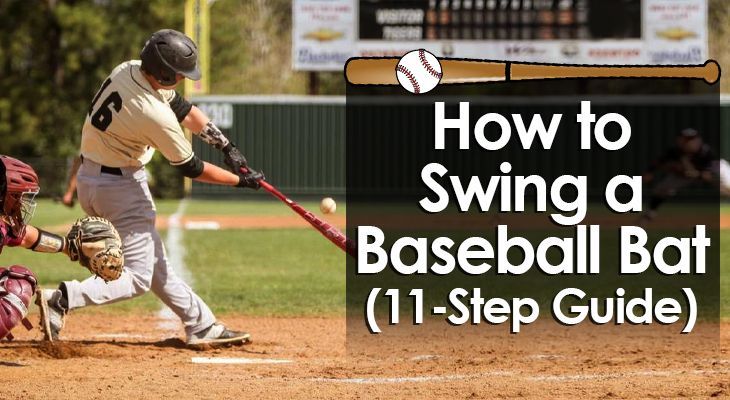Learning how to swing a baseball bat may seem like a simple task.
You pick up the bat by the handle, swing it as hard as you can, and that's it.
Many of the professionals make swinging a bat look very easy.
It seems that swinging a bat comes very natural to them, and it should to as well, right?
Don't forget, though, that these professionals have put in years of work to learn how to swing a baseball bat and to master that skill.
Swinging a baseball bat is, in fact, rather simple.
But, swinging a baseball bat correctly to give you the best chance to make solid contact is another thing entirely.
Learning the proper swing technique is very important if you want to consistently make hard contact, which is so essential if you want to become a good hitter in baseball.
Learn how to swing a baseball bat in 11 steps with this guide that can be broken down into three parts:
- The stance
- The grip
- The swing
How to Swing a Baseball Bat
The Stance
Step #1: Position Your Feet
Getting the proper stance is essential to swinging a baseball bat successfully.
You'll see batters utilize various different stances and styles when they step to the plate.
Generally speaking, though, they follow a consistent set of rules.
The first rule is to position your feet about shoulder width apart from each other, or even slightly wider than that.
Positioning them too close or too far away won't give you the proper balance and power.
Your feet should also be positioned parallel to each other, directly underneath your shoulders.
Your opposite side should be faced toward the pitcher (i.e. your left side forward if you're right-handed, and vice versa).
Position your head so it's pointed toward the pitcher.
Once you're positioned, you'll want to rest on the balls of your feet.
This will allow you to react more quickly to the pitch.
Step #2: Bend Your Knees
Now, you want to sink down into your feet by bending your knees.
You don't want to be in a full crouch, as a catcher will be.
You want to create a low center of gravity, but you want to be able to spring out of your stance using your hips and knees.
Step #3: Set Your Plant Foot
Your back foot will be your plant foot in your stance.
You want to keep this foot planted into the ground firmly.
This will help you keep your stance steady, which allows you to generate more power in your swing.
When you begin to swing, you'll take a tiny step forward with your front foot.
At the same time, you'll be twisting your back foot for the follow through.
Keep in mind that you want to keep both of your feet in place until your bat makes contact with the baseball.
Once you are set in this position, make sure you relax.
If you're too tense, it'll be harder for you to move in a fluid motion.
This will negatively affect your ability to generate power and make contact.
The Grip
Step #4: Position Your Hands
At the same time that you're setting up your body in the batter's box, you'll be positioning your hands on the bat.
You can practice this on the side during practice until you get it down.
First, lay the bat's handle across the eight fingers on your two hands (minus the thumbs, of course). Then, take your fingers and wrap them around the bat.
The bat should not be held by the palms of your hands.
Doing that will prevent you from rotating your wrists properly through the swing.
Position the pinky finger of your bottom hand near the knob of the bat.
You can move your hands up a bit (known as "choking up") but don't go too high on the handle.
Your dominant hand should be on top of your non-dominant hand (i.e. right hand on top of left hand for right-handed hitters).
Step #5: Line the Knuckles Up
When you wrap your fingers around the bat, the knuckles on all of your fingers should be aligned in one straight line.
This will allow the bat to shift when you swing, with your hands turning the handle naturally. Don't grip the bat too tight.
If this positioning of the bat isn't comfortable for you, you can adjust your knuckles a bit.
It's important that you are comfortable when holding the bat, otherwise, your swing won't be successful.
Step #6: Position the Bat
When you're in the batter's box, you want to point the bat up and angle it over your back shoulder.
You don't want to rest the bat on your shoulder or down your back.
It should be raised up off your shoulder a bit, which will allow you to be ready to swing.
You should aim to angle the bat at 45 degrees from your hands.
This will make it easier for you to swing with the most amount of power.
As you do this, you should make sure to keep your gravity centered over the feet.
Your knees, toes, hips and shoulders should also be in alignment, in a straight line down.
This will allow you to explode out of your stance and uncoil properly when the ball gets closer to you.
The Swing
Step #7: Small Step Forward
Once you are set, be prepared for the ball to come your way.
When the pitcher releases the ball from his hand, you want to step forward slightly with your front foot.
You don't want to move too far, and you also don't want to not move enough.
Aim for a step of about two to three inches forward.
While you're doing so, you should maintain your body's alignment.
This will allow you to generate as much power as possible behind your swing.
It's very easy to throw your balance off when you start stepping forward.
This is why you should make sure that your step is short and quick.
It will allow you to keep a solid base and in a good position to make solid contact with the baseball.
Step #8: Twist Your Hips
When learning how to swing a baseball bat, it's important to understand that a lot of the power from your swing will come from your hips.
As you're swinging, you want to rotate your hips.
This will create all the momentum behind your swing.
Make sure that you do this in a quick motion, and don't allow your hips to become misaligned with your body as you begin to twist.
Your hips should move counterclockwise if you're right handed and clockwise if you're left handed.
Your shoulders will follow closely behind your hips.
If you don't use your hips properly, you could easily get hurt.
Plenty of players sustain "core" muscle injuries when they try to generate a lot of power in their swing by just swinging their shoulders around.
This will put too much pressure on your hips and core of your body.
Step #9: Eyes on the Ball
This is probably one of the most famous sayings in baseball.
From the start of your swing all the way until the end, you want to make sure that you keep your eyes on the baseball.
You want to lock your eyes into the ball the entire time.
You want to stare at the pitcher before and as he starts his windup.
Then, pick up the ball as the pitcher releases it from his hand, and follow it all the way into your bat as you swing and make contact.
You want to keep your head low through your entire swing, and drop your chin down as well.
This will help you keep your head properly aligned with your entire body through your swing.
When you drop your chin, make sure not to tilt your head to the point where your eyes wouldn't be level.
If your eyes are not level, it could throw your perspective off and make it more difficult to focus on the baseball.
Track the ball all the way into your bat as it travels from the pitcher's hands to close to your bat.
You can practice this over and over again to see how different pitches travel toward you.
Step #10: Shift Your Shoulders
As you move the bat to make contact, you want to swing your shoulders out across your body. They should follow your hips as they rotate.
Again, make sure you don't tighten up during your swing.
You want your body to act like a spring -- it will uncoil as you swing, from your feet through to your hips through to your shoulders.
You also want to keep the shaft of your bat tight to your body in the first half of your swing. This will give you the leverage you need for a powerful swing.
Step #11: Follow Through
Once you make contact with the ball, you shouldn't stop.
You should continue your swing all the way through to the end.
This is called the follow through, and it is very similar to the follow through when you're throwing a baseball.
Your swing should end when the bat is extended out over the opposite shoulder.
Your upper body should face the pitcher at the end of your swing.
This action will give you all the power you need to drive the ball successfully.
When you're just learning how to swing, you want to try to keep both hands on the bat as you follow through.
Once you've mastered the swing, you may decide to keep just one hand on the bat. You'll see many players at the professional level do this.

Conclusion:
Learning how to swing a baseball bat is a three-step process that includes the stance, the grip and the swing.
Follow the standard steps above, and you'll be well on your way to mastering the art of a powerful and successful swing.
As you can see when you watch a professional baseball game, there are a lot of slight variations that players will do with each step in this process.
At first, follow the steps above as a definitive guide.
Then, make slight adjustments if you don't feel completely comfortable with any of those steps.
The most important thing is that you feel comfortable throughout your entire swing. If you don't, it will be hard for you to make consistent, powerful contact.

